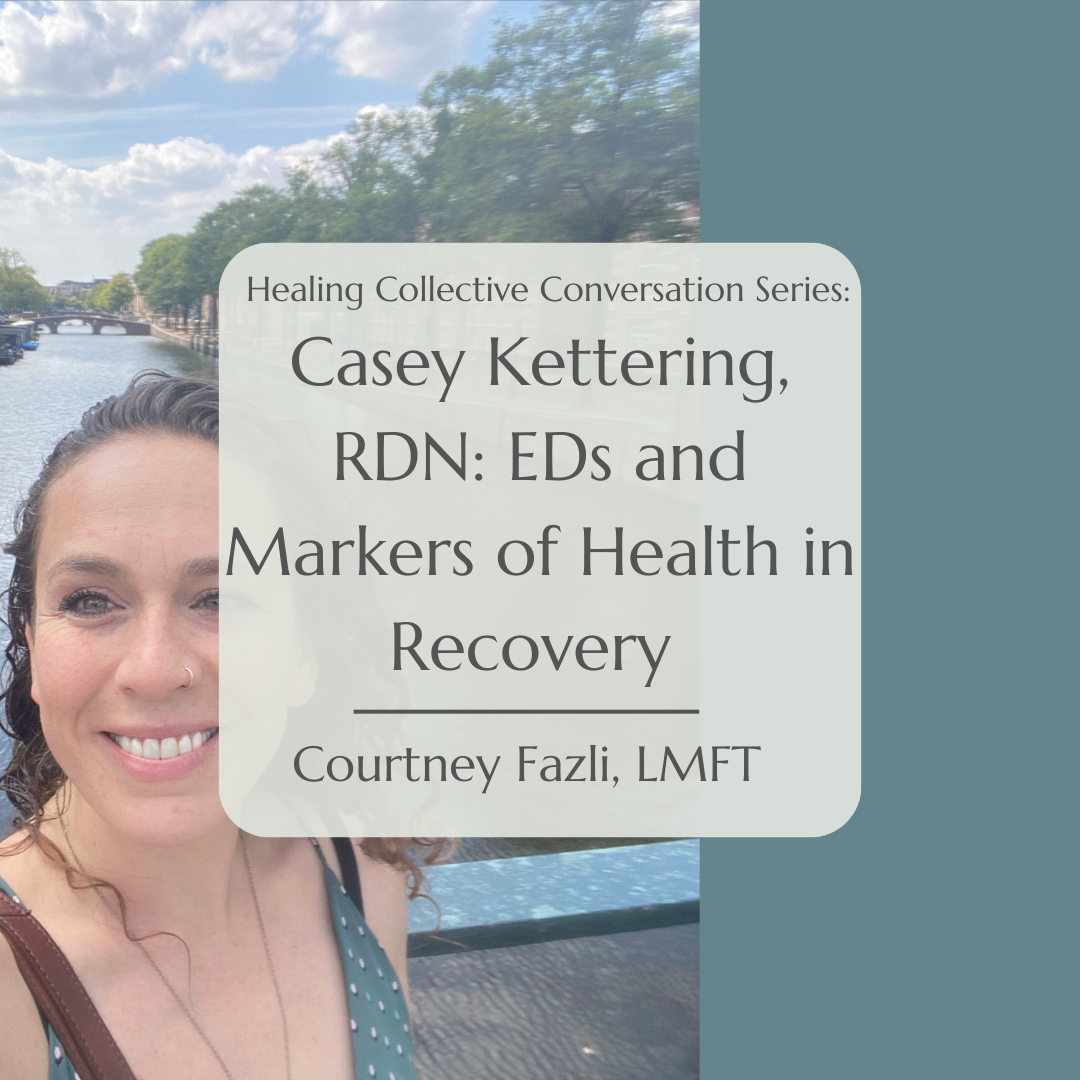Healing Collective Conversation Series: Casey Kettering & Markers of Health in Nutritional Therapy
Welcome to my second blog in my Healing Collective Conversation series. Next on the list is another dear colleague Casey Kettering RDN, who discusses the impactful ways eating disorders affect the body, common misconceptions about intuitive eating, and how reconnecting with internal cues can help restore balance, digestion, and overall well-being. If you’ve ever wondered how nutrition therapy supports lasting recovery, this conversation is for you.
Casey Kettering (she/her) is an RDN, having graduated with an MS in Nutrition from University of Illinois, Chicago & has been working in the clinical nutrition and eating disorder fields ever since. Becoming a dietitian was one of the happiest accidents of her life as she originally aimed to be a therapist, but found being a dietitian to be her thing. She recalls how much she “HATED” science in high school, but when she became interested in nutrition and had something to connect concepts to, it came to life for her. “I got hooked. I became a science nerd. And I love chemistry.” Casey loves being a dietitian and how it feels exactly like the right fit for her work and her ability to help her clients.
How do eating disorders impact physical health?
What I’ve learned over my practice is the profound way eating disorders have of messing with every system of the body, which I’ve seen both at the residential level of eating disorder treatment as well as at the community based hospital level. Unfortunately, we don’t really appreciate the degree to which that’s true until it’s WAY rough because as humans, we acclimate to our environment and internal states so readily. It’s a bit like the frog in the water situation – try to put a frog in boiling water, it’ll jump out. Put a frog in a pot of normal water and turn the heat on, the frog doesn’t realize the water is heating up until it’s in trouble. Lucky for us, the human body has tons of signs that things are amiss and it is extremely resilient, even in the context of recovering from long standing and severe eating disorders.
As eating disorders progress and get more severe, Bulimia Nervosa (BN) and Anorexia Nervosa (AN) can cause muscle fatigue and weakness, soft bones, and gastroparesis (i.e., much slower digestion), which can be painful. Anorexia can cause hypothyroidism. All can cause hyperlipidemia, or too much fat in the blood (though for different reasons), liver abnormalities, and even kidney issues. BN and binge eating disorder (BED) can contribute to developing diabetes, and other chronic conditions.
In really severe and prolonged cases of AN or BN, renal or liver failure, muscle pain, osteoperosis, seizures and death can all occur. All eating disorders leave people at greater risk for cardiovascular disease, though by different mechanisms. In other words, there isn’t an eating disorder that exists that doesn’t have profound impact on one’s physical health.
In what ways does nutritional therapy heal different markers of health in ED recovery?
Predominantly through Intuitive Eating (IE). To understand how IE balances out some of the damage caused by eating disorders, you have to understand IE as a system and practice by which a person follows their internal cues to make decisions about their food choices and intake. It helps to smooth out the more extreme swings that come from diet mentality and eating with an externalized locus of control (i.e., your mind telling you when to stop based on rules, expectations, or fear of others’ perceptions, that’s generally disconnected from your body).
Intuitive Eating is about connecting with and listening to internal cues from your body. This includes your hunger and fullness cues – determining how hungry you are, what foods would be satisfying to eat, how much of these foods would take care of you, and then when you are satisfied and can stop intake. However, it goes beyond these cues to include things like:
whether or not the foods you’re eating truly are what you’re wanting or needing
whether it actually feels good to your body to eat these foods at this time
understanding what flavors and textures create satisfaction;
what overall environment supports a satisfying eating experience.
When anyone is able to increasingly structure their intake so they’re able to eat when they’re truly hungry, stop when they’re satisfied and eat balanced meals, a ton of metabolic things can change and improve. It smooths out the rise and fall in blood sugar, normalizes hormones, increases sensitivity to hunger and satisfaction, levels out energy levels, supports appropriate digestion, and regulates mood, cognitive function, and sleep cycle.
Sounds like snake oil? Consider that eating consistent with what your body is saying is the way that the body was designed to function, and as one of the foundational needs of life, balancing intake contributes to the balancing of many other systems. When working with clients with prediabetes, non-alcoholic fatty liver disease, high triglycerides or cholesterol, applying IE principles tends to reverse their health conditions by addressing the impact of more inconsistent and disordered eating habits.
What’s a current favorite dish you like to share with your clients?
You want to start with a recipe that is a balanced meal and crazy delicious? I offer bibimbap, a Korean one-bowl dish that can be made a variety of ways from My Korean Kitchen. For a recipe with fewer ingredients, though not as authentic, check out Budget Bytes. Don’t like beef? Trade out with tofu. Don’t like spicy? Just use soy and maybe fish sauces. Don’t like some of the veggies? Omit, or swap ‘em out.
How can people connect with you to learn more about your work?
If you want to connect, have questions, or are interested in working together, you can check out my website or email me. Hope you found something useful for you in this!



